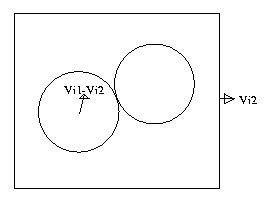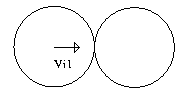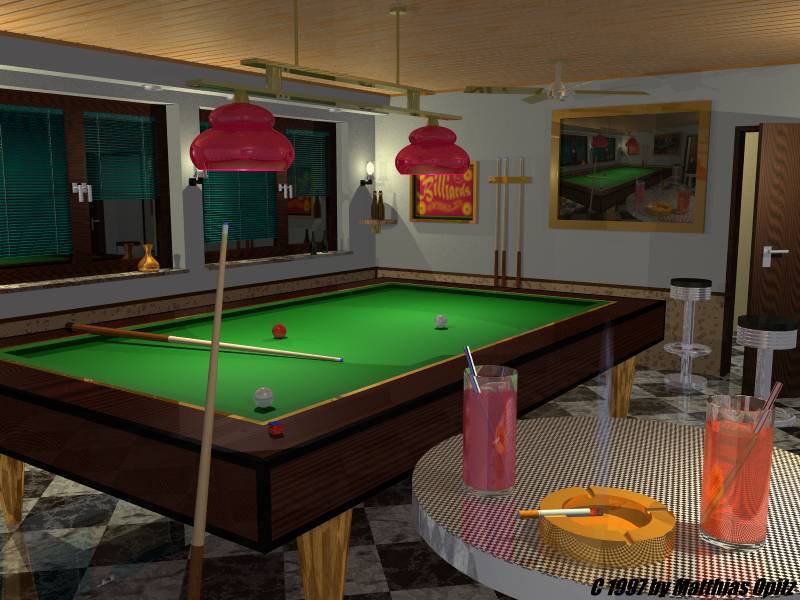********************
# BILLIARDS #
*************************
A Game Of Graphics & Skill !innovation of ......
| PRADEEP KUMAR SONKAR |
Y2268 |
pksonkar |
| PRANJALYA PARTH LATHE |
Y2272 |
pplathe |
| UTTAM KUMAR TRIPATHI |
Y2405 |
uttam |
We are greatly fascinated by this great game of billiards which is one of the oldest & the best skill games of the world .
Played in all the corners of the world & enjoyed by millions of people all across the world,this theme was constantly at
the back of our mind while we were planning our project for ESC101 course .I am a great admirer of this master game
& have been in constant touch with this game for last few years.All this lead to building of a great super-structure of
ideas , thoughts & sheer imagination on a solid foundation.
HOPE YOU ENJOY OUR CREATION ! ! !
THE KNOW HOW ABOUT THE GAME :-
The game consists of three balls (coloured : white , yellow & red) . It is played with the help of a cue on a six pocketedgreen carpet table .The game is all about manipulation of 2-D collisions at different angles, angular and linear momentum
conservations and your sheer grit and concentration.


The game starts with the red ball placed on the black dot at one end of the table. The player who starts the game places the
ball on the semi-circle present at the opposite end and takes his shot aiming at the red ball. Untill unless the second user
gets his chance with the yellow ball, the game proceeds with only two balls on the table. Each player has to aim other balls
using his own ball , if he hits the other player's ball then he will be left with only two balls to play with.
TERMS RELATED WITH BILLIARDS-
- POCKET- When the ball gets inside any one of the pocket.
- POD- When the red ball is pocketed.
- KNOFF-The ball belonging to the player being pocketed taking angle with the red ball.
- CANNON-When the player's ball hits the other two balls succesively.
POINTS-TALLY
| CANNON |
3 |
| KNOFF |
2 |
| POD |
1 |


SAMPLE INPUT/OUTPUT-
Mass = M
Initial velocity ball 1 = Vi1
Initial velocity ball 2 = Vi2
Final velocity ball 1 = Vf1
Final velocity ball 2 = Vf2
Final trajectory ball 1 = Zf1
Final trajectory ball 2 = Zf2
In the simplest collision scenario, a moving ball strikes a stationary ball straight on. In this situation, the system has a total momentum equal to the momentum of the moving ball. Assuming that energy is conserved in the collision, we can solve for the final velocities using the conservation of momentum.
P = MV
Pi = Pf
MVi1 = MVf1 + MVf2
Vi1 = Vf1 + Vf2
(Vi1 Vf1) = Vf2
(1/2)M(Vi1)2 = (1/2)M(Vf1)2 + (1/2)M(Vf2)2
(Vi1)2 = (Vf1)2 + (Vf2)2
(Vi1 + Vf1)(Vi1 Vf1) = (Vf2)2
(Vi1 + Vf1) = (Vf2) = (Vi1 Vf1)
Vf1 = 0
Vf2 = Vi1
This leaves us with an interesting conclusion. When a moving ball hits a stationary ball, all the momentum is transferred to the stationary ball. The shooting ball comes to a rest and the target ball continues on the path of the first ball. This phenomenon is only true when the masses are equal and energy is conserved in the collision.
When both balls are moving, we need to solve the system again, substituting the velocity of the second ball for Vi2.
Pi = MVi1 + MVi2
Pi = Pf
MVi1 + MVi2 = MVf1 + MVf2
Vi1 + Vi2 = Vf1 + Vf2
Vi1 - Vf1 = Vf2 - Vi2
(1/2)M(Vi1)2 + (1/2)M(Vi1)2 = (1/2)M(Vf1)2 + (1/2)M(Vf2)2
(Vi1)2 + (Vi1)2 = (Vf1)2 + (Vf2)2
(Vi1)2 - (Vf1)2 = (Vf2) 2 - (Vi2)2
(Vi1 + Vf1)(Vi1 - Vf1) = (Vf2 + Vi2)(Vf2 - Vi2)
(Vi1 + Vf1) = (Vf2 + Vi2)
Now we have two expressions to find two unknown variables, which are the final velocities of the balls.
Vi1 + Vf1 = Vf2 + Vi2
Vi1 - Vf1 = Vf2 - Vi2
The problem becomes more complex if the colliding ball does not strike the stationary ball head-on, but rather at an angle. To simplify the problem, we can say that the moving ball is traveling along the x-axis. In this situation, we can set up three equations. First, momentum in the x-direction must be conserved. Second, momentum in the y-direction must be conserved. Lastly, we can assume energy is conserved in the collision due to the unique rigid properties of billiard balls.
Since only one ball is moving, the momentum is defined as MVi1. After the collision, the x-components of the momentums of each ball must equal the initial momentum of the first ball. Because the first ball is initially traveling in the x-direction, there is no component to the momentum in the y-direction. Therefore, the sum of the y-components of momentum must equal 0 after the collision. Lastly, energy is conserved. The kinetic energy of the first ball before the collision must equal the sum of the energies after the collision. A negligible amount of energy is lost to air vibrations, and can be ignored. There are four unknown values that we need for after the collision: the velocity and deflection angle of each ball.
MVi1 = MVf1cos(Zf1) + MVf2cos(Zf2)
Vi1 = Vf1cos(Zf1) + Vf2cos(Zf2)
MVf1sin(Zf1) + MVf2sin(Zf2) = 0
Vf1sin(Zf1) + Vf2sin(Zf2) = 0
(1/2)M(Vi1)2 = (1/2)M(Vf1)2 + (1/2)M(Vf2)2
(Vi1)2 = (Vf1)2 + (Vf2)2
There are only three equations, which only allows us to solve for three of the variables. Fortunately, we can find one of the variables independently. The only accelerating force acting on the second ball is generated by the collision with the first ball. Newton's first law maintains that that ball can only travel in the direction of the force applied. We can find this direction geometrically by tracing a line between the centers of the two balls. The target ball must then follow this line. Therefore, we can solve for Zf2 independently. This leaves us with three equations with three unknown variables, which is a solvable problem.
Vf1 = (Vi1 - Vf2cos(Zf2))/(cos(Zf1))
Vf2 = (tan(Zf1)Vi1)/(cos(Zf2)tan(Zf1) + sin(Zf2))
Vf22 = Vi12 - Vf12
(tan(Zf1)Vi1)/(cos(Zf2)tan(Zf1) + sin(Zf2))2 =
Vi12 - (Vi1/cos(Zf1) - [cos(Zf2)tan(Zf1)Vi1 /( cos(Zf1) cos(Zf2)tan(Zf1) + sin(Zf2) )]2
The only unknown variable in this equation is Zf1. We can now plug the value of Zf2 back into the expressions for Vf1 and Vf2, and solve the entire system.
The collision becomes even more complex when both balls are moving before the collision. This problem can be solved, however, by applying a different reference frame. We can redefine both balls in a moving coordinate system. Newton's laws still remain true as long as the coordinate system, or "reference frame", does not accelerate. Let us now define the velocity of the reference frame. To simplify the problem, we define the velocity of the reference frame to have the same magnitude and direction as the target ball. To define the balls in the new reference frame we merely subtract the velocity vector of the target ball from each of the balls in the system.
In the new reference frame, it now appears as if the target ball is stationary, and we can calculate the collision as before. After we find the correct final velocity and deflection angle for each ball, we need to transfer the balls back the original reference frame. We do this by adding the velocity vector of the reference frame back to each of the balls.
PARAMETERS GIVEN BY THE USER-
- VELOCITY
- ANGLE OF PROJECTION
- FRICTION COEFFICIENT
- MOMENT OF INERTIA OF THE
BALLS
REFERENCES && LINKS :-
- java essentials -C.HORSTMANN

